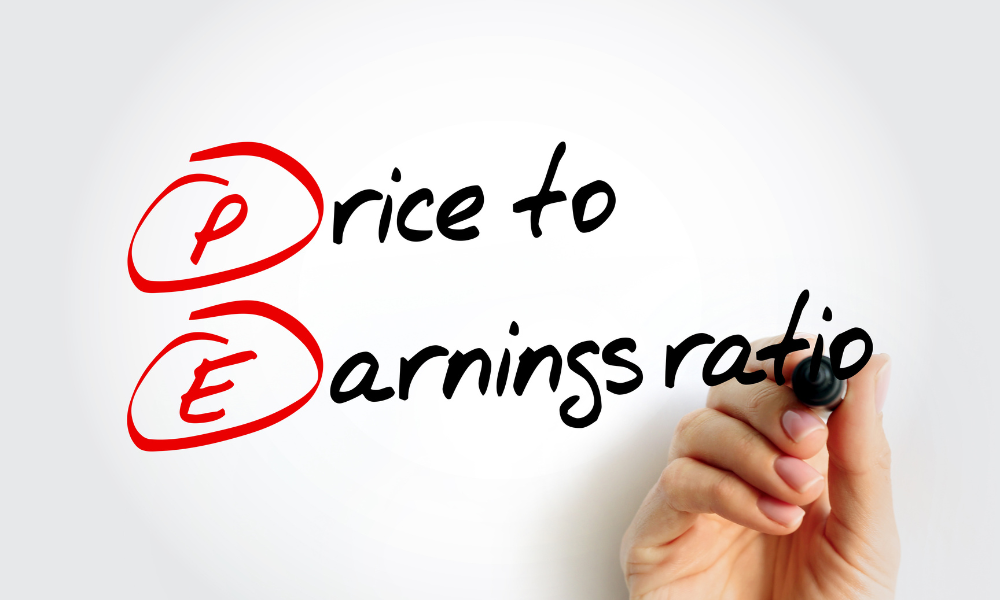Learn all about price-to-earnings ratio when you read this guide. Discover what it is, why it matters, and how it can help you assess stocks for your clients

The price-to-earnings ratio, often referred to as the P/E ratio, is one of the most widely used valuation tools in finance. Understanding how this ratio works and how it applies to fundamental analysis is necessary when helping your clients choose the best stocks.
Your clients will most likely look to you for guidance on which stocks offer strong potential, and the P/E ratio provides a starting point for those discussions. In this article, Wealth Professional Canada will highlight the price-to-earnings ratio. We'll explore what it is and how it is calculated. Want to know what a good P/E ratio is? Read on for more.
What the P/E ratio measures
The price-to-earnings ratio compares a company’s share price to its earnings per share (EPS). It tells investors how much they are paying for one dollar of earnings.
A higher ratio suggests that investors are willing to pay more relative to current earnings, which might indicate expectations of positive growth. A lower ratio might suggest that the stock is undervalued or that the company faces challenges.
Explaining this concept in plain terms can help your clients better understand why some stocks are more expensive than others and how valuation impacts long-term performance. Watch this video to learn more about P/E ratio:
The EPS and the price-to-earnings ratio are just two examples of metrics that one can use when conducting fundamental analysis.
How the P/E ratio is calculated
To find the P/E ratio, use this formula:

For example, if a company’s stock trades at $50 and its EPS is $5, the P/E ratio is 10. That means investors are paying $10 for every $1 of earnings.
The earnings per share are calculated from the company’s net income divided by the number of outstanding shares. EPS can vary depending on whether it is based on the last 12 months (trailing) or projected earnings (forward).
Trailing versus forward P/E ratios
There are two main versions of the P/E ratio that you need to know:
- Trailing P/E ratio: this uses the company’s actual earnings from the past 12 months; it is backward-looking and based on reported results
- Forward P/E ratio: this uses projected earnings for the next 12 months; it is forward-looking and based on analyst estimates
Both forms have value. Trailing P/E offers a concrete picture of historical performance, while forward P/E provides a sense of market expectations.
What is a good P/E ratio?
A good price-to-earnings ratio depends on factors such as:
- the type of company
- the industry it operates in
- the current market environment
In industries such as banking or utilities, lower P/E ratios are common because earnings are steady while growth is slower. In sectors such as technology, higher ratios can be expected because investors believe future earnings will grow quickly.
It is important for you to explain to your clients that there is no universal number that’ll always be considered good. A company with a P/E ratio of 12 might be undervalued if it has high growth potential. However, another with a ratio of 25 could still be attractive if earnings are expected to rise sharply.
The best way to judge whether a P/E ratio is good is to compare it with the company’s historical average as well as the ratios of similar businesses. You can also check the growth outlook. This approach can help your clients understand why the same number can mean different things in different situations.
What does P/E ratio indicate?
The price-to-earnings ratio indicates how much investors are willing to pay today for a company’s earnings. It measures the relationship between the stock price and earnings per share. This shows how the market values the company’s ability to generate profits.
A high ratio tells us that investors expect the company to grow and are prepared to pay more for its future earnings. A low ratio might suggest the company is undervalued or that the market is uncertain about its future performance.
The P/E ratio is a useful tool to explain valuation to your clients. It allows easy comparisons between companies in the same industry. For example, if two Canadian banks are analyzed and one trades at a higher P/E ratio, your clients can see that the market values its future growth more highly. At the same time, the ratio can highlight companies that might be trading at a discount compared to their peers.
The P/E ratio is not a prediction by itself, but it is an important signal of your clients’ expectations. It can help them see the balance between what they pay for a stock and the earnings it produces.
At what P/E ratio is a stock overvalued?
There is no fixed P/E ratio that always means a stock is overvalued. What seems high for one industry might be normal for another. A utility company with a P/E ratio above 25 might look expensive because earnings growth is usually slow in that sector. A technology company with the same ratio might not be considered overvalued if earnings are expected to grow quickly.
If a stock’s price-to-earnings ratio is much higher than similar companies or its own past average, it might be overpriced. This is especially true if there’s little sign of strong future earnings growth.
However, as a financial advisor, you should remind your clients that labeling a stock as overvalued based on the P/E ratio alone can be misleading. The ratio should be weighed alongside other considerations such as:
- revenue growth
- debt levels
- competitive advantages
- market conditions
Using the P/E ratio in context makes the analysis more reliable and avoids simplistic conclusions. Here's why it can be the key to evaluating a stock purchase:
The best financial advisors in Canada are certainly knowledgeable about the price-to-earnings ratio and how to use it to judge whether a stock is fairly valued.
What is the problem with the P/E ratio?
The price-to-earnings ratio is useful, but it has some limitations. One problem is that it relies on earnings. This means that it can be affected by temporary events or accounting methods. A company might report lower or higher earnings in a given year due to one-time factors. This will make the P/E ratio less meaningful. Another issue is that if earnings are negative, the ratio cannot be calculated.
The P/E ratio also varies widely across industries. This makes comparisons between different sectors unreliable. For example, a mining company and a bank might have very different ratios even if both are fairly valued.
Another weakness is that the ratio does not account for debt, cash flow, or dividends. A company with strong earnings but heavy debt could still have an attractive P/E ratio, but its financial position might be risky.
Because of these problems, you must explain to your clients that the P/E ratio should never be the only metric used for investment decisions. It works best when combined with other financial measures to provide a more complete view of valuation and risk.
Interpreting high versus low P/E ratios
A high price-to-earnings ratio can signal positive growth expectations. Investors might believe the company will increase earnings quickly, justifying the higher valuation. However, it can also indicate that the stock is overpriced.
A low price-to-earnings ratio can suggest that a stock is undervalued compared to its earnings. On the other hand, it could reflect real risks such as declining demand or weaker competitive position.
Remind your clients that the P/E ratio is a tool, not a verdict. It provides context but must be considered alongside other indicators.
Comparing companies via their P/E ratios
The P/E ratio is most effective when used to compare companies within the same sector. For example, comparing two Canadian banks such as the Royal Bank of Canada (RBC) and the Toronto-Dominion Bank (TD) can be more meaningful than comparing a bank to a mining company. Each industry has its own typical valuation range.
You can use this to demonstrate whether a stock trades above or below the industry average. This allows your clients to see if they are paying a premium for growth potential or getting a discount that might or might not be justified.
Limitations of the P/E ratio
While the price-to-earnings ratio is useful, it has some limitations:
- Earnings volatility: earnings can fluctuate due to one-time events, making the ratio misleading
- Negative earnings: if a company reports negative earnings, the P/E ratio is not meaningful
- Industry differences: ratios vary widely across industries, limiting cross-sector comparisons
- Reliance on accounting: earnings are based on accounting methods that might not always reflect true cash flow
You need to highlight these limitations when explaining the price-to-earnings ratio to your clients. Be sure that they understand that it is just one part of a larger toolkit.
P/E ratios and portfolio management
When building portfolios, you can use P/E ratios to balance exposure between growth and value stocks. A mix of higher and lower P/E companies can help manage risk while positioning for returns.
The impact of interest rates on P/E ratios
Interest rates play a major role in determining valuations. When interest rates are low, investors often accept higher P/E ratios because other assets such as bonds provide lower returns. When rates rise, P/E ratios might fall as earnings must justify higher costs of capital.
Long-term perspective on P/E ratios
P/E ratios should be considered in the context of long-term investing. Short-term movements in earnings or share price can distort the ratio. You should encourage your clients to look beyond temporary fluctuations and focus on the company’s long-term prospects.
Over time, companies with sustainable earnings growth often justify higher P/E ratios. On the contrary, those with declining performance might see ratios shrink.
Why you should discuss P/E ratios with your clients
As a financial advisor, you need to explain financial concepts in a way that your clients can easily understand. A helpful approach is to use real-world examples. For instance, telling a client that a price-to-earnings ratio of 15 means paying $15 for every $1 of earnings makes the concept concrete.
You can also provide comparisons, such as showing how two Canadian companies in the same industry have different P/E ratios and why. This can help your clients see the ratio as part of a bigger picture rather than an abstract number. Overall, when your clients understand P/E ratios and other valuation metrics, they are more confident in your advice and more engaged in the investment process.
Want to read similar articles? Check out our Investor Resources page for more.



